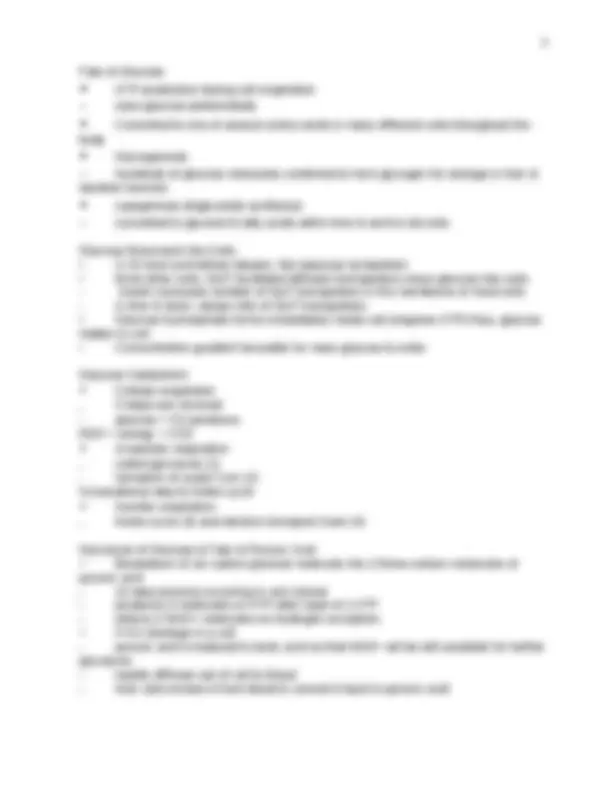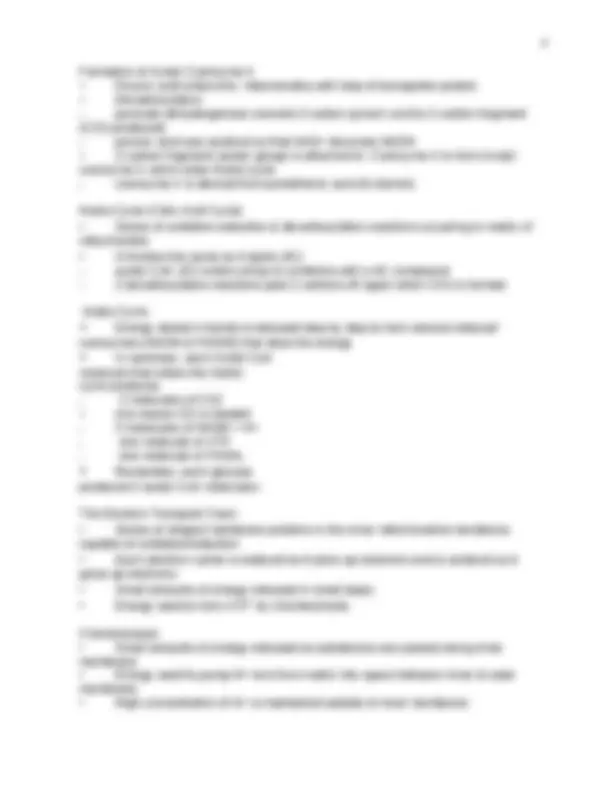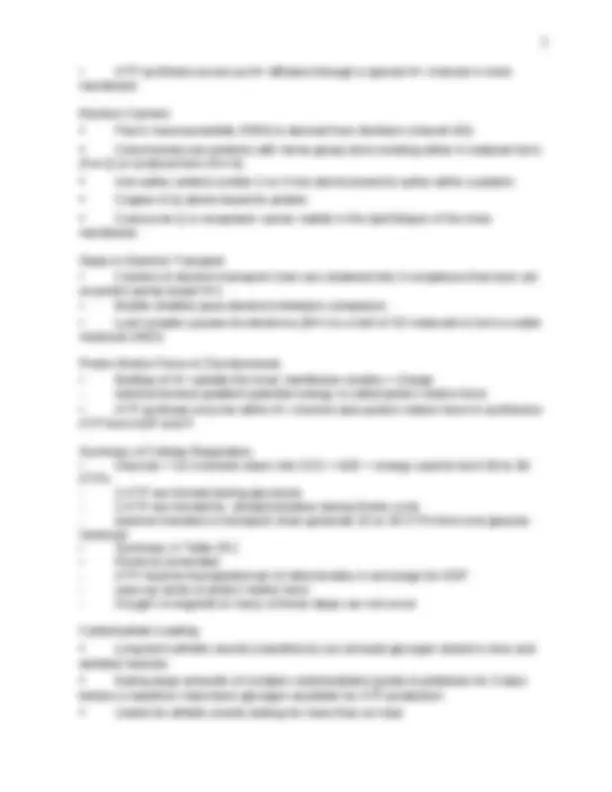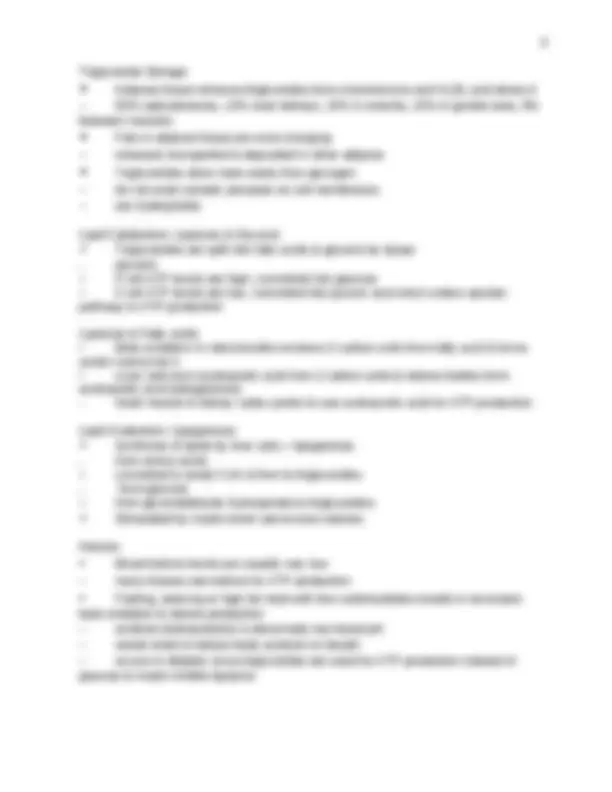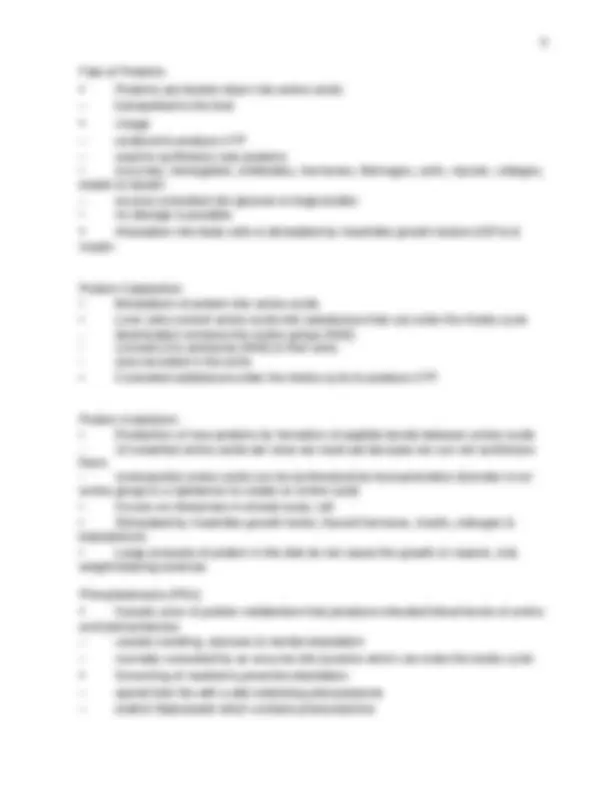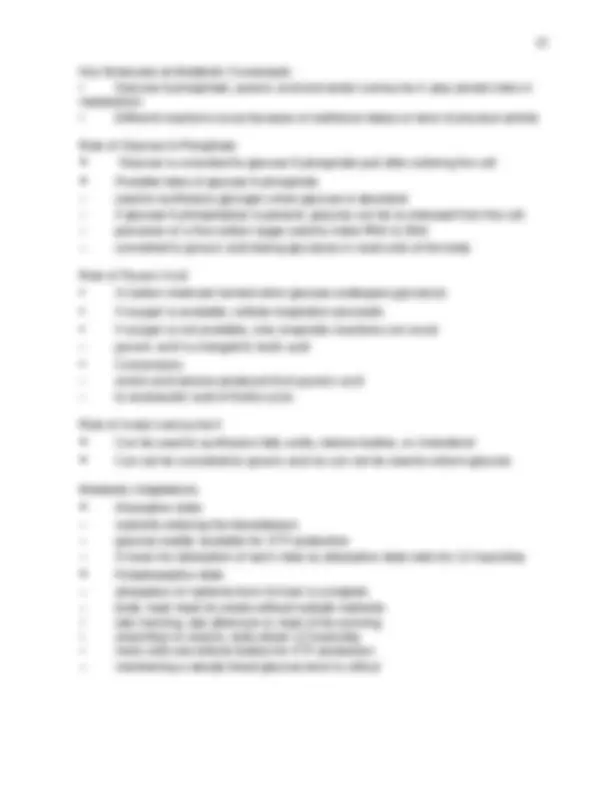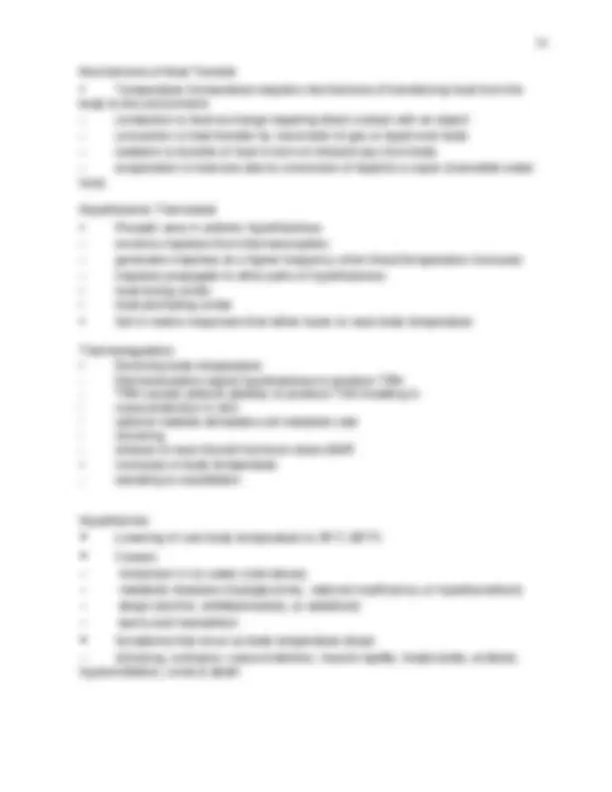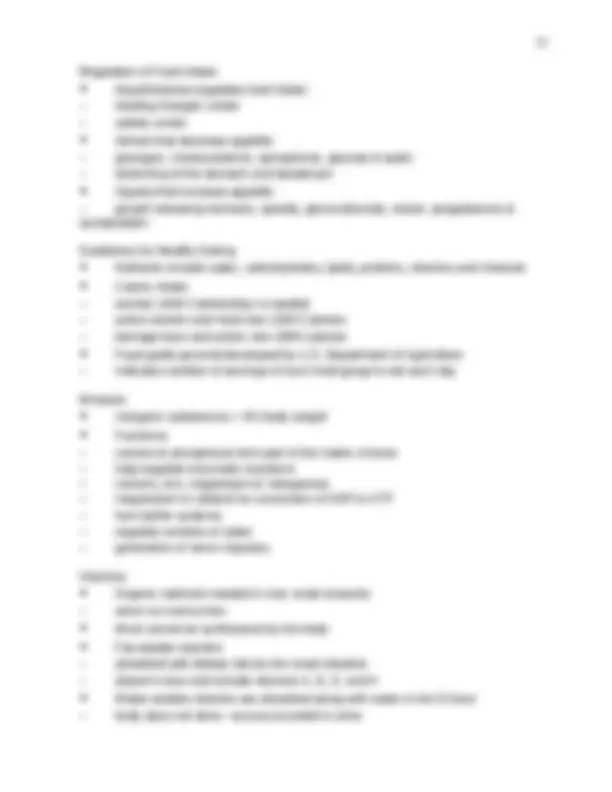Download Notes on Metabolism - Human Anatomy and Physiology I | BIOL 1151 and more Study notes Physiology in PDF only on Docsity!
Chapter 25 Metabolism Objectives: Role of ATP in anabolism and catabolism Oxidation-reduction reactions Carbohydrate metabolism Lipid metabolism Protein metabolism Heat and energy balance Nutrition – guidelines, minerals and vitamins Metabolism
• Functions of food
– source of energy
– essential nutrients
– stored for future use
• Metabolism is all the chemical reactions of the body
– some reactions produce the energy stored in ATP that other reactions consume
– all molecules will eventually be broken down and recycled or excreted from the
body Catabolism and Anabolism
• Catabolic reactions breakdown complex organic compounds
– providing energy (exergonic)
– glycolysis, Krebs cycle and electron transport
• Anabolic reactions synthesize complex molecules from small molecules
– requiring energy (endergonic)
• Exchange of energy requires use of ATP (adenosine triphosphate) molecule.
ATP Molecule & Energy
- Each cell has about 1 billion ATP molecules that last for less than one minute
- Over half of the energy released from ATP is converted to heat Energy Transfer
• Energy is found in the bonds between atoms
• Oxidation is a decrease in the energy content of a molecule
• Reduction is the increase in the energy content of a molecule
• Oxidation-reduction reactions are always coupled within the body
– whenever a substance is oxidized, another is almost simultaneously reduced.
Oxidation and Reduction
• Biological oxidation involves the loss of (electrons) hydrogen atoms
– dehydrogenation reactions require coenzymes to transfer hydrogen atoms to
another compound
– common coenzymes of living cells that carry H+
- NAD (nicotinamide adenine dinucleotide )
- NADP (nicotinamide adenine dinucleotide phosphate )
- FAD (flavin adenine dinucleotide )
• Biological reduction is the addition of electrons (hydrogen atoms) to a molecule
– increase in potential energy of the molecule
Mechanisms of ATP Generation
• Phosphorylation is
– bond attaching 3rd phosphate group contains stored energy
• Mechanisms of phosphorylation
– within animals
- substrate-level phosphorylation in cytosol
- oxidative phosphorylation in mitochondria
– in chlorophyll-containing plants or bacteria
- photophosphorylation. Phosphorylation in Animal Cells
• In cytoplasm (1)
• In mitochondria (2, 3 & 4)
Carbohydrate Metabolism--In Review
• In GI tract
– polysaccharides broken down into simple sugars
– absorption of simple sugars (glucose, fructose & galactose)
• In liver
– fructose & galactose transformed into glucose
– storage of glycogen (also in muscle)
• In body cells --functions of glucose
– oxidized to produce energy
– conversion into something else
– storage energy as triglyceride in fat
Formation of Acetyl Coenzyme A
- Pyruvic acid enters the mitochondria with help of transporter protein
- Decarboxylation
- pyruvate dehydrogenase converts 3 carbon pyruvic acid to 2 carbon fragment (CO2 produced)
- pyruvic acid was oxidized so that NAD+ becomes NADH
- 2 carbon fragment (acetyl group) is attached to Coenzyme A to form Acetyl coenzyme A which enter Krebs cycle
- coenzyme A is derived from pantothenic acid (B vitamin). Krebs Cycle (Citric Acid Cycle)
- Series of oxidation-reduction & decarboxylation reactions occurring in matrix of mitochondria
- It finishes the same as it starts (4C)
- acetyl CoA (2C) enters at top & combines with a 4C compound
- 2 decarboxylation reactions peel 2 carbons off again when CO2 is formed Krebs Cycle
- Energy stored in bonds is released step by step to form several reduced coenzymes (NADH & FADH2) that store the energy
- In summary: each Acetyl CoA molecule that enters the Krebs cycle produces
- 2 molecules of C
- one reason O2 is needed
- 3 molecules of NADH + H+
- one molecule of ATP
- one molecule of FADH 2
- Remember, each glucose produced 2 acetyl CoA molecules The Electron Transport Chain
- Series of integral membrane proteins in the inner mitochondrial membrane capable of oxidation/reduction
- Each electron carrier is reduced as it picks up electrons and is oxidized as it gives up electrons
- Small amounts of energy released in small steps
- Energy used to form ATP by chemiosmosis Chemiosmosis
- Small amounts of energy released as substances are passed along inner membrane
- Energy used to pump H+ ions from matrix into space between inner & outer membrane
- High concentration of H+ is maintained outside of inner membrane
- ATP synthesis occurs as H+ diffuses through a special H+ channel in inner membrane Electron Carriers
• Flavin mononucleotide (FMN) is derived from riboflavin (vitamin B2)
• Cytochromes are proteins with heme group (iron) existing either in reduced form
(Fe+2) or oxidized form (Fe+3)
• Iron-sulfur centers contain 2 or 4 iron atoms bound to sulfur within a protein
• Copper (Cu) atoms bound to protein
• Coenzyme Q is nonprotein carrier mobile in the lipid bilayer of the inner
membrane Steps in Electron Transport
• Carriers of electron transport chain are clustered into 3 complexes that each act
as proton pump (expel H+)
• Mobile shuttles pass electrons between complexes
• Last complex passes its electrons (2H+) to a half of O2 molecule to form a water
molecule (H2O) Proton Motive Force & Chemiosmosis
• Buildup of H+ outside the inner membrane creates + charge
- electrochemical gradient potential energy is called proton motive force
• ATP synthase enzyme within H+ channel uses proton motive force to synthesize
ATP from ADP and P Summary of Cellular Respiration
- Glucose + O2 is broken down into CO2 + H2O + energy used to form 36 to 38 ATPs
- 2 ATP are formed during glycolysis
- 2 ATP are formed by phosphorylation during Krebs cycle
- electron transfers in transport chain generate 32 or 34 ATPs from one glucose molecule
- Summary in Table 25.
- Points to remember
- ATP must be transported out of mitochondria in exchange for ADP
- uses up some of proton motive force
- Oxygen is required or many of these steps can not occur Carbohydrate Loading
• Long-term athletic events (marathons) can exhaust glycogen stored in liver and
skeletal muscles
• Eating large amounts of complex carbohydrates (pasta & potatoes) for 3 days
before a marathon maximizes glycogen available for ATP production
• Useful for athletic events lasting for more than an hour
Classes of Lipoproteins
• Chylomicrons (2 % protein)
- form in intestinal epithelial cells to transport dietary fat
- apo C-2 activates enzyme that releases the fatty acids from the chylomicron for absorption by adipose & muscle cells
- liver processes what is left
• VLDLs (10% protein)
- transport triglycerides formed in liver to fat cells
• LDLs (25% protein) --- “bad cholesterol”
- carry 75% of blood cholesterol to body cells
- apo B100 is docking protein for receptor-mediated endocytosis of the LDL into a body cell
- if cells have insufficient receptors, remains in blood and more likely to deposit cholesterol in artery walls (plaque)
• HDLs (40% protein) --- “good cholesterol”
- carry cholesterol from cells to liver for elimination Blood Cholesterol
• Sources of cholesterol in the body
- food (eggs, dairy, organ meats, meat)
- synthesized by the liver
• All fatty foods still raise blood cholesterol
- liver uses them to create cholesterol
- stimulate reuptake of cholesterol containing bile normally lost in the feces
• Desirable readings for adults
- total cholesterol under 200 mg/dL; triglycerides 10-190 mg/dL
- LDL under 130 mg/dL; HDL over 40 mg/dL
- cholesterol/HDL ratio above 4 is undesirable risk
• Raising HDL & lowering cholesterol can be accomplished by exercise, diet &
drugs Fate of Lipids
• Oxidized to produce ATP
• Excess stored in adipose tissue or liver
• Synthesize structural or important molecules
– phospholipids of plasma membranes
– lipoproteins that transport cholesterol
– thromboplastin for blood clotting
– myelin sheaths to speed up nerve conduction
– cholesterol used to synthesize bile salts and steroid hormones.
Triglyceride Storage
• Adipose tissue removes triglycerides from chylomicrons and VLDL and stores it
– 50% subcutaneous, 12% near kidneys, 15% in omenta, 15% in genital area, 8%
between muscles
• Fats in adipose tissue are ever-changing
– released, transported & deposited in other adipose
• Triglycerides store more easily than glycogen
– do not exert osmotic pressure on cell membranes
– are hydrophobic
Lipid Catabolism: Lipolysis & Glycerol
• Triglycerides are split into fatty acids & glycerol by lipase
- glycerol
- if cell ATP levels are high, converted into glucose
- if cell ATP levels are low, converted into pyruvic acid which enters aerobic pathway to ATP production Lipolysis & Fatty acids
- Beta oxidation in mitochondria removes 2 carbon units from fatty acid & forms acetyl coenzyme A
- Liver cells form acetoacetic acid from 2 carbon units & ketone bodies from acetoacetic acid (ketogenesis)
- heart muscle & kidney cortex prefer to use acetoacetic acid for ATP production Lipid Anabolism: Lipogenesis
• Synthesis of lipids by liver cells = lipogenesis
- from amino acids
- converted to acetyl CoA & then to triglycerides
- from glucose
- from glyceraldehyde 3-phosphate to triglycerides
• Stimulated by insulin when eat excess calories
Ketosis
• Blood ketone levels are usually very low
– many tissues use ketone for ATP production
• Fasting, starving or high fat meal with few carbohydrates results in excessive
beta oxidation & ketone production
– acidosis (ketoacidosis) is abnormally low blood pH
– sweet smell of ketone body acetone on breath
– occurs in diabetic since triglycerides are used for ATP production instead of
glucose & insulin inhibits lipolysis
Key Molecules at Metabolic Crossroads
• Glucose 6-phosphate, pyruvic acid and acetyl coenzyme A play pivotal roles in
metabolism
• Different reactions occur because of nutritional status or level of physical activity
Role of Glucose 6-Phosphate
• Glucose is converted to glucose 6-phosphate just after entering the cell
• Possible fates of glucose 6-phosphate
– used to synthesize glycogen when glucose is abundant
– if glucose 6-phosphatase is present, glucose can be re-released from the cell
– precursor of a five-carbon sugar used to make RNA & DNA
– converted to pyruvic acid during glycolysis in most cells of the body
Role of Pyruvic Acid
• 3-carbon molecule formed when glucose undergoes glycolysis
• If oxygen is available, cellular respiration proceeds
• If oxygen is not available, only anaerobic reactions can occur
– pyruvic acid is changed to lactic acid
• Conversions
– amino acid alanine produced from pyruvic acid
– to oxaloacetic acid of Krebs cycle
Role of Acetyl coenzyme A
• Can be used to synthesize fatty acids, ketone bodies, or cholesterol
• Can not be converted to pyruvic acid so can not be used to reform glucose
Metabolic Adaptations
• Absorptive state
– nutrients entering the bloodstream
– glucose readily available for ATP production
– 4 hours for absorption of each meal so absorptive state lasts for 12 hours/day
• Postabsorptive state
– absorption of nutrients from GI tract is complete
– body must meet its needs without outside nutrients
- late morning, late afternoon & most of the evening
- assuming no snacks, lasts about 12 hours/day
- more cells use ketone bodies for ATP production
– maintaining a steady blood glucose level is critical
Metabolism during Absorptive State
• Body cells use glucose for ATP production
– about 50% of absorbed glucose
• Storage of excess fuels occur in hepatocytes, adipocytes & skeletal muscle
– most glucose entering liver cells is converted to glycogen (10%) or triglycerides
– dietary lipids are stored in adipose tissue
– amino acids are deaminated to enter Krebs cycle or are converted to glucose or
fatty acids
– amino acids not taken up by hepatocytes used by other cells for synthesis of
proteins Regulation of Metabolism during Absorptive State
• Beta cells of pancreas release insulin
• Insulin’s functions
– increases anabolism & synthesis of storage molecules
– decreases catabolic or breakdown reactions
– promotes entry of glucose & amino acids into cells
– stimulates phosphorylation of glucose
– enhances synthesis of triglycerides
– stimulates protein synthesis along with thyroid & growth hormone
Metabolism During Postabsorptive State
• Maintaining normal blood glucose level (70 to 110 mg/100 ml of blood) is major
challenge
– glucose enters blood from 3 major sources
- glycogen breakdown in liver produces glucose
- glycerol from adipose converted by liver into glucose
- gluconeogenesis using amino acids produces glucose
– alternative fuel sources are
- fatty acids from fat tissue fed into Krebs as acetyl CoA
- lactic acid produced anaerobically during exercise
- oxidation of ketone bodies by heart & kidney
• Most body tissue switch to utilizing fatty acids, except brain still need glucose.
Regulation of Metabolism During Postabsorptive State
• As blood glucose level declines, pancreatic alpha cells release glucagon
– glucagon stimulates gluconeogenesis & glycogenolysis within the liver
• Hypothalamus detects low blood sugar
– sympathetic neurons release norepinephrine and adrenal medulla releases
norepinephrine & epinephrine
- stimulates glycogen breakdown & lipolysis
- ingestion of food raises BMR 10-20%
- children’s BMR is double that of an elderly person
Mechanisms of Heat Transfer
• Temperature homeostasis requires mechanisms of transferring heat from the
body to the environment
– conduction is heat exchange requiring direct contact with an object
– convection is heat transfer by movement of gas or liquid over body
– radiation is transfer of heat in form of infrared rays from body
– evaporation is heat loss due to conversion of liquid to a vapor (insensible water
loss) Hypothalamic Thermostat
• Preoptic area in anterior hypothalamus
– receives impulses from thermoreceptors
– generates impulses at a higher frequency when blood temperature increases
– impulses propagate to other parts of hypothalamus
- heat-losing center
- heat-promoting center
• Set in motion responses that either lower or raise body temperature
Thermoregulation
• Declining body temperature
- thermoreceptors signal hypothalamus to produce TRH
- TRH causes anterior pituitary to produce TSH resulting in
- vasoconstriction in skin
- adrenal medulla stimulates cell metabolic rate
- shivering
- release of more thyroid hormone raises BMR
• Increases in body temperature
- sweating & vasodilation Hypothermia
• Lowering of core body temperature to 35°C (95°F)
• Causes
– immersion in icy water (cold stress)
– metabolic diseases (hypoglycemia, adrenal insufficiency or hypothyroidism)
– drugs (alcohol, antidepressants, or sedatives)
– burns and malnutrition
• Symptoms that occur as body temperature drops
– shivering, confusion, vasoconstriction, muscle rigidity, bradycardia, acidosis,
hypoventilation, coma & death
– includes the B vitamins and vitamin C
Antioxidant Vitamins
• C, E and beta-carotene (a provitamin)
• Inactivate oxygen free radicals
– highly reactive particles that carry an unpaired electron
- damage cell membranes, DNA, and contribute to atherosclerotic plaques
- arise naturally or from environmental hazards such as tobacco or radiation
• Protect against cancer, aging, cataract formation, and atherosclerotic plaque
Vitamin and Mineral Supplements
• Eat a balanced diet rather than taking supplements
• Exceptions
– iron for women with heavy menstrual bleeding
– iron & calcium for pregnant or nursing women
– folic acid if trying to become pregnant
- reduce risk of fetal neural tube defects
– calcium for all adults
– B12 for strict vegetarians
– antioxidants C and E recommended by some
Fever
• Abnormally high body temperature
– toxins from bacterial or viral infection = pyrogens
– heart attacks or tumors
– tissue destruction by x-rays, surgery, or trauma
– reactions to vaccines
• Beneficial in fighting infection & increasing rate of tissue repair during the course
of a disease
• Complications -- dehydration, acidosis, & brain damage.
Obesity
• Body weight more than 20% above desirable standard
• Risk factor in many diseases
– cardiovascular disease, hypertension, pulmonary disease,
– non-insulin dependent diabetes mellitus
– arthritis, certain cancers (breast, uterus, and colon),
– varicose veins, and gallbladder disease.

